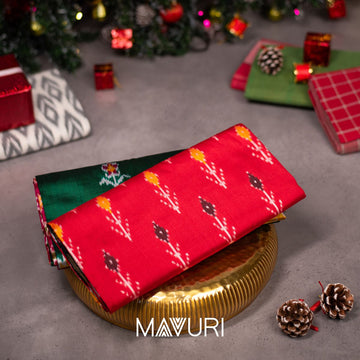
All About Ikat Silk Sarees: Weaving, Types & History
Imagine fabric where the design is not printed, but is woven with threads itself, forms a pattern with a soft, ether blur. This is an Ikat silk saree! These are not just beautiful clothes; They are textile stories manufactured with a dyeing and weaving process, which is really captivating. If you are ready for fashion that keeps deep cultural roots, Ikat is your new passion. Let's ignore the world of Ikat silk sarees, detecting their ancient origin for stunning varieties.
What is Ikat Weaving? The Magic Behind the Threads
Ikat is a masterclass in resist-dyeing yarn before it hits the loom. Artisans meticulously bind sections of warp (vertical) or weft (horizontal) threads (or both!) with specific materials. These bound areas resist the dye when dipped into vibrant color baths. When woven, subtle dye bleeding creates that signature, slightly staining, "feather" effect - the surefire identity of the true IKAT. It is a dance between accurate and biological beauty. That soft spot is not a mistake; It is the signature of authenticity, which makes every Ikat saree truly unique.
A Journey Through Time: The History of Ikat
The story of IKAT expands globally as its pattern. This ancient technique is not limited to a origin; It spread to the continents for centuries.Its spread was made smooth by ancient trade routes. Historically, IKAT was a symbol of the situation due to its labor-intensive process. Royal families treasured these fabrics. Each region embracing Ikat developed unique styles and patterns, telling distinct cultural narratives. From Silk Road connections to its flourishing under Indian dynasties, Ikat has adapted while safeguarding its artistic integrity.
Regional Riches: Types of Ikat Silk Sarees in India
India is an abundant wellspring of diverse Ikat traditions, each region adding its unique character. Here are some of the most celebrated types of Ikat silk sarees:
1. Odisha Ikat (Sambalpuri, Bomkai, Sonepuri)
Odisha is a major center for the Indian Ekat, known as "Bandha".
Weaving style: often wraping a (double ekat), yield complex, geometric, or illustrated pattern.
Design and color: Vibrant color (red, black, white, yellow) with nature-inspired (elephant, flowers) or spiritual motifs (temple boundaries).
The vibe: perfect for bold patterns and soil elegance, celebration or traditional meetings.
2. Pochampally Ikat (Telangana)
From Bhoodan Pochampally, this Ikat is known for precise geometric patterns.
Weaving Style: Predominantly double Ikat, achieving astonishing sharpness and symmetry.
Designs & Colors: Iconic diamond, square, and abstract geometric motifs. Bold, contrasting colors (deep blues, reds, greens, yellows).
The Vibe: Contemporary feel despite traditional roots, versatile for formal and semi-casual events.
3. Patola Ikat (Gujarat)
The legendary patan patola sarees from Patan are the absolute zenith of Ikat. Rare and prized, they are heirlooms.
Weaving Style: Pinnacle of double Ikat. Both warp and weft threads dyed with pinpoint accuracy. Front and back look identical.
Designs & Colors: Elaborate geometric, floral, dancing figures, and animal patterns. Intense, vibrant colors.
The Vibe: Symbol of supreme luxury and tradition, reserved for grand weddings.
Styling Your Ikat Silk Saree: Modern Meets Tradition
Ikat silk sarees are dynamic due to their unique patterns, bridging classic charm with contemporary flair.
Effortless Minimalism: Drape in simple Nivi style with minimal jewelry. The patterns are statement enough.
Belt It Up: Cinch a sleek metallic belt at your waist for instant modern structure and edge.
Creative Blouse Play: Experiment with your blouse! A contrasting solid, a contemporary cut, or even a minimalist crop top refreshes the look.
Layered Look: For a touch of sophistication, add a tailored jacket or ethnic shrug.
Caring for Your Precious Ikat Silk Saree
Your Ikat silk saree is an investment. Proper care is essential for longevity:
Dry Clean Only: Safest for preserving silk and dyes.
Store Thoughtfully: Fold neatly in a breathable cotton bag. Avoid direct sunlight and moisture.
Handle with Care: Silk is delicate. Avoid harsh chemicals or excessive pulling.
Mavuri Artisanal Weaves: Weaving the Ikat Legacy
At Mavuri Artisanal Weaves, Ikat art is passionately celebrated. Their IKAT silk saree is a will of carefully craftsmanship, combining traditional accuracy with contemporary aesthetics. Each Mavuri is a wearable work of ikat saree art, a story woven with heritage and modern elegance. Choosing a Mavuri Ikat Saree means investing in a piece of saree and quality that respects the tradition while fitting in your stylish wardrobe.
Final Words: Embrace the Ikat Magic!
Ikat silk sarees are more than beautiful garments; they are a profound celebration of artistry, history, and weaving skill. From ancient techniques to stunning regional variations, every Ikat saree tells a unique tale. By understanding its process, history, and types, you appreciate the craftsmanship. So go ahead, find your perfect Ikat piece, style it your way, and carry this amazing legacy with pride! Which unique Ikat style has captured your imagination?




